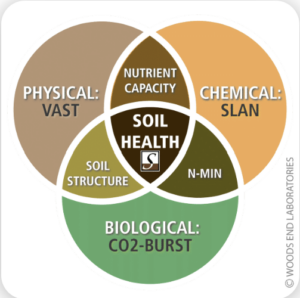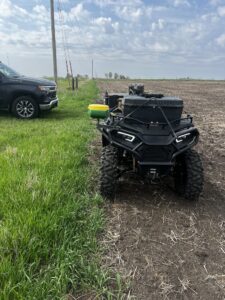As the value and importance of soil health becomes more mainstream, many producers are interested in soil health testing. Comprehensive Soil health packages can be expensive, ranging anywhere from $45-$300+ per sample so its important that producers see the return on investment.
Two critical parameters to a soil health test that can help realize this ROI are soil respiration and organic nitrogen. Together, they can help understand nitrogen use in your system and inform management decisions to limit reliability on expensive, synthetic fertilizers.
Soil Respiration: A Measure of Microbial Activity
Soil respiration refers to the process by which microorganisms in the soil decompose organic matter, releasing carbon dioxide (CO₂) into the atmosphere. This microbial activity is a critical component of the soil’s life cycle. The rate of soil respiration is often used as a proxy for microbial activity and overall soil biological activity. A higher rate of respiration generally indicates a higher level of biological activity and healthier soil.
Organic Nitrogen: The Hidden Key to Soil Fertility
Organic nitrogen refers to nitrogen that is part of organic compounds in the soil, typically found in plant and animal residues, microorganisms, and decaying organic matter. Unlike inorganic nitrogen, which exists in simple forms like ammonium (NH₄⁺) or nitrate (NO₃⁻) and is directly used by plants, organic nitrogen is more complex and tends to be bound up in proteins, amino acids, and other organic molecules. Soil microorganisms play a critical role in transforming organic nitrogen into forms that plants can absorb, such as ammonium (NH₄⁺) and nitrate (NO₃⁻) through processes like mineralization and nitrification. Measuring organic nitrogen helps us understand nutrient availability in the soil, soil fertility, and nutrient cycling processes.
Healthy soils typically have a well-balanced nitrogen cycle, where organic nitrogen is broken down and converted into plant-available forms by a robust and diverse microbial communities
The Complementary Relationship
Soil respiration and organic nitrogen are intimately connected, and together they provide a more complete picture of nutrient availability.
For soil to be truly healthy, it requires two things:
- A strong microbial community—a diverse and active population of soil organisms that can break down organic matter and support nutrient cycling.
- A reliable food source—enough organic matter (including organic nitrogen) for these microbes to feed on and thrive.
Measuring soil respiration can tell you that the microbes are active at a certain moment, but it doesn’t provide the full picture of soil health. Respiration rates can fluctuate based on immediate conditions (like temperature or moisture) and might not always reflect the long-term health of the microbial community. For example, respiration might be high because microbes are briefly in a favorable environment, but if the soil lacks organic nitrogen (a key food source), the microbial community might not be sustainable in the long run.
By also testing for organic nitrogen in the soil, you’re getting more information about whether there is a steady, long-term food supply for the microbes. This gives you a more complete understanding of the sustainability of the microbial community. If there’s enough organic nitrogen, the microbes will have a steady food source to support their activity and growth. Without it, the microbial community might struggle over time, even if respiration rates appear healthy for short periods.
Learn With Us

What Your Soil Isn’t Telling You: The Power of Pairing Respiration with Organic Nitrogen
Spring is in full swing, and farmers and agronomists alike are gearing up for a new growing season. With the

5 Ways to Prepare for a Productive Growing Season
Spring is in full swing, and farmers and agronomists alike are gearing up for a new growing season. With the

The 5 Benefits of RTK Field Boundaries
In today’s precision agriculture, accurate field boundaries are essential for optimizing operations and maximizing crop yields. Whether you’re working with